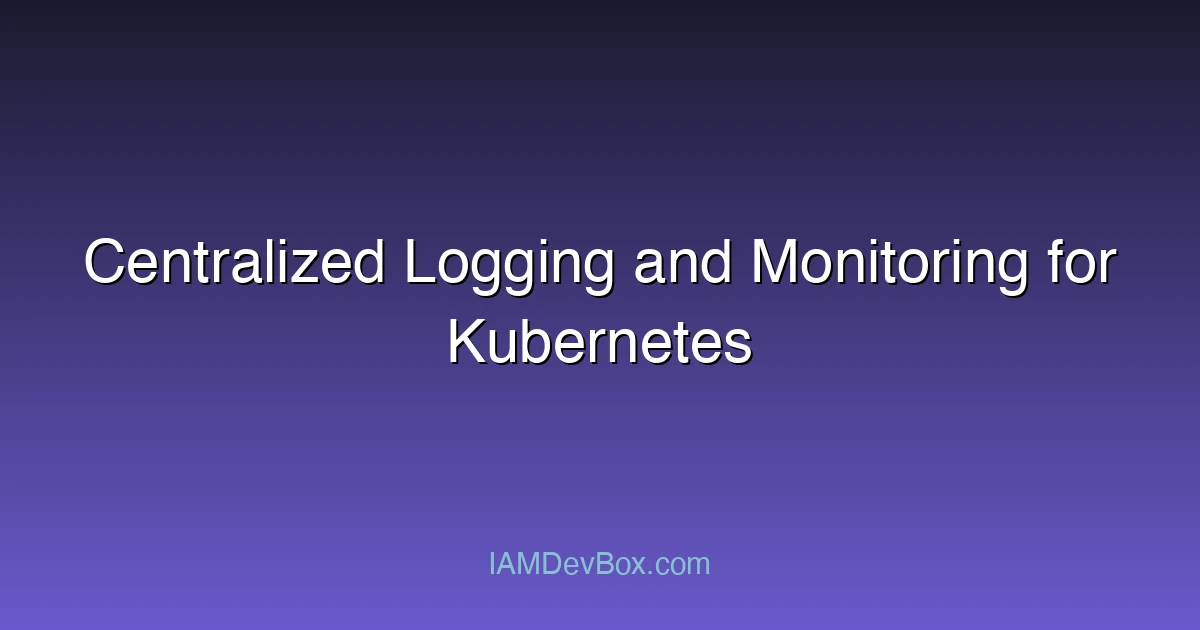In the dynamic world of container orchestration, Kubernetes stands out as a leader, offering scalability and flexibility for modern applications. However, with this complexity comes the need for effective observability—centralized logging and monitoring are essential components. This blog post will guide you through the implementation of a comprehensive logging and monitoring system for your Kubernetes cluster.
Visual Overview:
graph TB
subgraph "Kubernetes Cluster"
subgraph "Control Plane"
API[API Server]
ETCD[(etcd)]
Scheduler[Scheduler]
Controller[Controller Manager]
end
subgraph "Worker Nodes"
Pod1[Pod]
Pod2[Pod]
Pod3[Pod]
end
API --> ETCD
API --> Scheduler
API --> Controller
API --> Pod1
API --> Pod2
API --> Pod3
end
style API fill:#667eea,color:#fff
style ETCD fill:#764ba2,color:#fff
Introduction to Centralized Logging and Monitoring
Centralized logging and monitoring in Kubernetes involve collecting, storing, and analyzing logs and metrics from all components within your cluster. This setup allows you to gain insights into system health, troubleshoot issues, and ensure compliance.
Key Components
- Logging Agent: Collects logs from pods and nodes.
- Log Shipper: Transports logs to a centralized storage system.
- Centralized Log Store: Stores logs for long-term access and analysis.
- Visualization Tool: Provides dashboards and alerts for monitoring.
Tools and Solutions
Kubernetes offers flexibility in choosing tools for logging and monitoring. Common choices include:
- Prometheus: For metrics collection and monitoring.
- Grafana: For visualizing metrics and creating dashboards.
- Elasticsearch, Logstash, Kibana (ELK Stack): For log management and visualization.
Prometheus and Grafana Setup
Here’s how to deploy Prometheus and Grafana in your Kubernetes cluster:
apiVersion: v1
kind: ServiceAccount
metadata:
name: prometheus
namespace: monitoring
---
apiVersion: rbac.authorization.k8s.io/v1
kind: ClusterRoleBinding
metadata:
name: prometheus
roleRef:
apiGroup: rbac.authorization.k8s.io
kind: ClusterRole
name: cluster-admin
subjects:
- kind: ServiceAccount
name: prometheus
namespace: monitoring
---
apiVersion: apps/v1
kind: Deployment
metadata:
name: prometheus
namespace: monitoring
spec:
replicas: 1
selector:
matchLabels:
app: prometheus
template:
metadata:
labels:
app: prometheus
spec:
containers:
- name: prometheus
image: /images/posts/centralized-logging-and-monitoring-for-kubernetes-87b10667.webp
ports:
- containerPort: 9090
volumeMounts:
- name: prometheus-config
mountPath: /etc/prometheus
volumes:
- name: prometheus-config
configMap:
name: prometheus-config
---
apiVersion: v1
kind: Service
metadata:
name: prometheus
namespace: monitoring
spec:
selector:
app: prometheus
ports:
- name: web
port: 9090
targetPort: 9090
type: ClusterIP
Implementation Steps
1. Define Your Monitoring Requirements
- Metrics: CPU, memory usage, request latency.
- Logs: Application logs, system logs.
2. Choose and Deploy Tools
Use the ELK Stack or Prometheus/Grafana based on your needs.
3. Configure Data Collection
Ensure all pods and nodes are monitored. Use DaemonSets for node-level monitoring.
4. Set Up Alerting
Configure alerts in Prometheus or Grafana for critical metrics.
5. Visualize and Analyze
Create dashboards in Grafana or Kibana to monitor key metrics and logs.
Text-Based Diagram: Logging Flow
+-------------------+ +-------------------+ +----------------------+
| Pods | | Log Shipper | | Centralized |
| (Generate Logs) | ---> | (e.g., Fluentd) | ---> | Log Store |
+-------------------+ +-------------------+ | (e.g., Elasticsearch)|
+----------------------+
Best Practices
- Centralize Everything: Ensure all logs and metrics are collected centrally.
- Monitor Everything: Track cluster, node, and pod-level metrics.
- Set Up Alerts: Configure alerts for critical issues.
- Secure Your Data: Implement role-based access and encryption.
🎯 Key Takeaways
- Elasticsearch, Logstash, Kibana (ELK Stack)
- kind: ServiceAccount
- Centralize Everything
Conclusion
Implementing a centralized logging and monitoring system in Kubernetes is vital for maintaining a healthy and scalable environment. By choosing the right tools and following best practices, you can enhance observability and ensure your applications run smoothly.
FAQs
-
Why is centralized logging and monitoring important for Kubernetes? Centralized systems provide comprehensive visibility into cluster health, enabling effective troubleshooting and proactive management.
-
What tools are commonly used for logging and monitoring in Kubernetes? Prometheus, Grafana, and the ELK Stack are widely used for metrics and log management.
-
How can I ensure my logging and monitoring setup scales with my Kubernetes cluster? Use scalable tools and architectures, such as the ELK Stack or Prometheus Operator, designed for Kubernetes.
-
What are the best practices for implementing a centralized logging and monitoring solution? Centralize all data, monitor all components, set up alerts, and ensure security.
-
How do I correlate logs and metrics in a Kubernetes environment? Use tools like Grafana that allow you to correlate logs and metrics for deeper insights.
